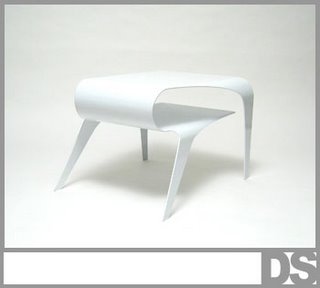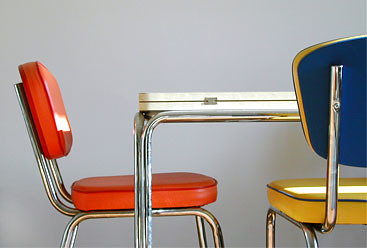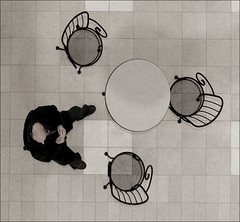Row over tables
 It comes with the usual Design Bull about inspiration and affordance.
It comes with the usual Design Bull about inspiration and affordance.I wanted to design a piece with personality and character, something for the free-spirited individual, not the generic masses.
Yes. Free spirited individual and the curve. Yes, we see the relationship. Although I'm not saying it's bad. It's not. It's a fine piece of furniture and has the potential of being a conversation piece in itself. Covered with other cool stuff in your living room, it'll be a great addition to your IKEA stuffed living space.
Like the designer said, it's not for the masses. I wouldn't use this table to put everyday stuff on it. Sure, there's the extra room, but those curved ends kind of make me feel insecure that my stuff will fall off.
Now having a "regular" table (like the one above), doesnt give you that feeling because it has clearly marked out edges. So even though both the tables may have the same surface area, and you can stack the same about of stuff on both, you feel more safe using the regular one. It's called visceral design.
And it's not just about straight edged tables. It's about horizontally flat tables. Would you feel anxiety putting stuff on a round table? Look at the photo below... I dont think you will. Would you put your computer monitor on a rectangular or flat table? You might, ok the round one will be awkward when you're sitting, but you wont have the same anxiety as when you use the curved table from the top.
Why? I'd say because fundamentally the idea of a table is to keep things from falling down. When I put something on a table I expect it to stay there. Consider a smooth surface table with a slope and no barrier on the sloping end. Causes anxiety.
Of course, since a regular table is safe, it's used everywhere and that's why it's called "regular", which also means boring, or at least not something you'd want as a centerpiece.
I'd say Furniture design is probably the most important design discipline. It has the most relevance to the majority of human population (at least the ones who can afford a chair). Good graphic design is important, but graphics talk to our mind. We see a good graphic and feel good. But an uncomfortable chair, is quite literally, a pain in the ass.
A lot of famous designers have been furniture designers... or so I've heard, the only one I know of is Charles Eames and his Wife Ray Eames, who designed the famous Eames Louge Chair (below), and published The India Report which was cruicial for the establishment of the National Institute of Design.
 Inviting? You betcha!! Sexy? Relaxing?? All of the above. It's called Affordance, you look at something and you know exactly how to use it, because it's form is self explanatory. You want to sit your ass in this, put your head on the head rest, lean back a little and put your feet up on the ottoman, drink beer and watch porn. Or maybe not.
Inviting? You betcha!! Sexy? Relaxing?? All of the above. It's called Affordance, you look at something and you know exactly how to use it, because it's form is self explanatory. You want to sit your ass in this, put your head on the head rest, lean back a little and put your feet up on the ottoman, drink beer and watch porn. Or maybe not.Look at this other example:
Reminds you of a govenment office, complete with pan chewing babus and slow squeeking cieling fans, doesnt it? But it happens to be a design breakthrough of it's time. No back support and using the material's own tensile properties. [Wikipedia]
A cantilever chair has no back legs, relying for support on the tensile properties of the material from which it is made (originally steel tubing). This famous form was pioneered by several people, but was officially designed by the Dutch designer Mart Stam in 1926, and remains an important example of 20th century design.
Another designer of Cantilever chair design was Hungarian designer Marcel Breuer who was experimenting with new designs with steel tubing.
So anyway, why am I going on and on about chairs and tables? Because I'm trying to relate furniture design with software design. Not the technical s/w design, but Interaction Design of a software.
Think about it. The most amount of time spent in a day for most of us is with Furniture.... and you guessed it, Software. Sitting on a chair, using a computer...... ring a bell?
So while furniture design has got better over the ages, software still is a pain in the ass. Well to be fair, lots of software. How does anxiety level of a user affect software design? In many ways... Consider this, as I'm writing all this and copy pasting the HTML for the images I've been saving the draft after every change. Blogger does it automatically too, but I dont trust my net connection. There's anxiety.
Ok that was a weak example. And I ran out of time also... but the point is made. I'll be trying to link furniture and software design in furthere posts... right now I gotta go and my back hurts from this chair :P



» Post a Comment